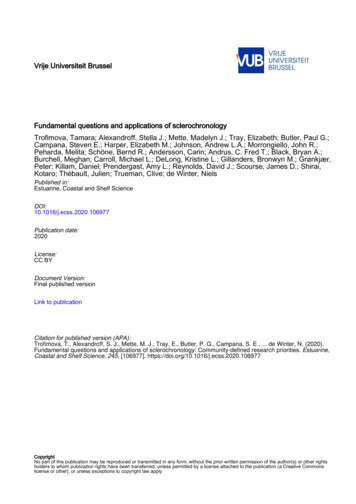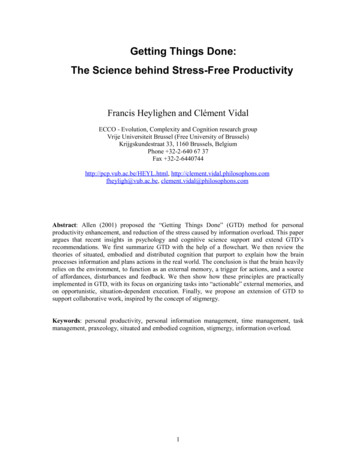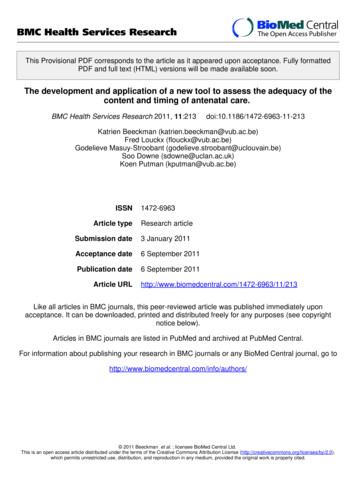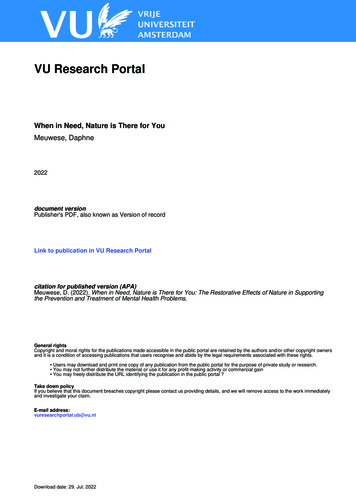
Transcription
Vrije Universiteit BrusselFundamental questions and applications of sclerochronologyTrofimova, Tamara; Alexandroff, Stella J.; Mette, Madelyn J.; Tray, Elizabeth; Butler, Paul G.;Campana, Steven E.; Harper, Elizabeth M.; Johnson, Andrew L.A.; Morrongiello, John R.;Peharda, Melita; Schöne, Bernd R.; Andersson, Carin; Andrus, C. Fred T.; Black, Bryan A.;Burchell, Meghan; Carroll, Michael L.; DeLong, Kristine L.; Gillanders, Bronwyn M.; Grønkjær,Peter; Killam, Daniel; Prendergast, Amy L.; Reynolds, David J.; Scourse, James D.; Shirai,Kotaro; Thébault, Julien; Trueman, Clive; de Winter, NielsPublished in:Estuarine, Coastal and Shelf ScienceDOI:10.1016/j.ecss.2020.106977Publication date:2020License:CC BYDocument Version:Final published versionLink to publicationCitation for published version (APA):Trofimova, T., Alexandroff, S. J., Mette, M. J., Tray, E., Butler, P. G., Campana, S. E., . de Winter, N. (2020).Fundamental questions and applications of sclerochronology: Community-defined research priorities. Estuarine,Coastal and Shelf Science, 245, [106977]. tNo part of this publication may be reproduced or transmitted in any form, without the prior written permission of the author(s) or other rightsholders to whom publication rights have been transferred, unless permitted by a license attached to the publication (a Creative Commonslicense or other), or unless exceptions to copyright law apply.
Estuarine, Coastal and Shelf Science 245 (2020) 106977Contents lists available at ScienceDirectEstuarine, Coastal and Shelf Sciencejournal homepage: http://www.elsevier.com/locate/ecssFundamental questions and applications of sclerochronology:Community-defined research prioritiesTamara Trofimova a, *, Stella J. Alexandroff b, c, Madelyn J. Mette a, Elizabeth Tray d,Paul G. Butler c, Steven E. Campana e, Elizabeth M. Harper f, Andrew L.A. Johnson g,John R. Morrongiello h, Melita Peharda i, Bernd R. Schöne j, Carin Andersson a,C. Fred T. Andrus k, Bryan A. Black l, Meghan Burchell m, Michael L. Carroll n,Kristine L. DeLong o, Bronwyn M. Gillanders p, Peter Grønkjær q, Daniel Killam r,Amy L. Prendergast s, David J. Reynolds l, James D. Scourse c, Kotaro Shirai t, Julien Thébault u,Clive Trueman v, Niels de Winter w, xaNORCE Norwegian Research Centre, Bjerknes Centre for Climate Research, NorwaySchool of Ocean Sciences, Bangor University, Wales, UKCollege of Life and Environmental Sciences, University of Exeter, UKdMarine and Freshwater Research Centre, Galway-Mayo Institute of Technology, IrelandeLife and Environmental Sciences, University of Iceland, Reykjavik, IcelandfUniversity of Cambridge, UKgSchool of Environmental Sciences, University of Derby, UKhSchool of BioSciences, University of Melbourne, AustraliaiInstitute of Oceanography and Fisheries, Split, CroatiajInstitute of Geosciences, University of Mainz, Mainz, GermanykUniversity of Alabama, USAlLaboratory of Tree-Ring Research, University of Arizona, USAmMemorial University, CanadanAkvaplan-niva, Tromsø, NorwayoDepartment of Geography and Anthropology and the Coastal Studies Institute, Louisiana State University, USApSchool of Biological Sciences, University of Adelaide, AustraliaqDepartment of Biology, Aarhus University, DenmarkrBiosphere 2, University of Arizona, USAsSchool of Geography, University of Melbourne, AustraliatAtmosphere and Ocean Research Institute, The University of Tokyo, JapanuUniv Brest, CNRS, IRD, Ifremer, LEMAR, F-29280, Plouzane, FrancevOcean and Earth Science, University of Southampton, UKwDepartment of Earth Sciences, Utrecht University, Utrecht, the NetherlandsxAMGC Research Group, Vrije Universiteit Brussel, Brussels, BelgiumbcA B S T R A C THorizon scanning is an increasingly common strategy to identify key research needs and frame future agendas in science. Here, we present the results of the first suchexercise for the field of sclerochronology, thereby providing an overview of persistent and emergent research questions that should be addressed by future studies.Through online correspondence following the 5th International Sclerochronology Conference in 2019, participants submitted and rated questions that addressed eitherknowledge gaps or promising applications of sclerochronology. An initial list of 130 questions was compiled based on contributions of conference attendees and reviewedby expert panels formed during the conference. Herein, we present and discuss the 50 questions rated to be of the highest priority, determined through an online surveydistributed to sclerochronology community members post the conference. The final list (1) includes important questions related to mechanisms of biological control overbiomineralization, (2) highlights state of the art applications of sclerochronological methods and data for solving long-standing questions in other fields such as climatescience and ecology, and (3) emphasizes the need for common standards for data management and analysis. Although research priorities are continually reassessed, ourlist provides a roadmap that can be used to motivate research efforts and advance sclerochronology toward new, and more powerful, applications.* Corresponding author.E-mail address: tatr@norceresearch.no (T. 977Received 1 February 2020; Received in revised form 15 July 2020; Accepted 4 August 2020Available online 9 September 20200272-7714/ 2020 The Authors. Published by Elsevier Ltd. This is an open access article under the CC BY license (http://creativecommons.org/licenses/by/4.0/).
T. Trofimova et al.Estuarine, Coastal and Shelf Science 245 (2020) 1069771. Introduction2. MethodologySclerochronology is a rapidly developing field of research. Whilegrowth bands in hard tissues of some organisms have long been observedand studied (e.g., Pulteney, 1781; Maton, 1805; Isely, 1914; Ma, 1934;Davenport, 1938; Adams, 1940; Kohler, 1964; Clark, 1974; Jones, 1981,1983), the term “sclerochronology” was first introduced to the publishedliterature in the 1970s. Analogous to the long-established field ofdendrochronology (e.g., Fritts et al., 1971), sclerochronology was orig inally defined as “the study of growth patterns in calcareous exo skeletons and shells” (Buddemeier et al., 1974) and was first applied tocoral research (Buddemeier et al., 1974; Hudson et al., 1976). The termhas since been broadened to include various terrestrial and aquatic taxawith growth patterns, whereby the most common examples are fish (e.g., Coulson et al., 2014; Martino et al., 2019), coralline algae (e.g.,Halfar et al., 2011; Williams et al., 2017), gastropods (e.g., Surge et al.,2013; Prendergast and Schöne, 2017) and bivalves (e.g., Jones et al.,1989). The list of sclerochronological archives is continuously expand ing as more species are being assessed for their utility in sclerochrono logical studies. The term was redefined during the First InternationalSclerochronology Conference held at St. Petersburg, FL, USA in 2007 as“ the study of physical and chemical variations in the accretionaryhard tissues of organisms, and the temporal context in which theyformed ” (Oschmann, 2009).Today, sclerochronology is an increasingly diverse and interdisci plinary field. Apart from utilizing a wide array of archives, scle rochronology employs a suite of morphological, geochemical,microstructural, and crystallographic techniques. The data provided bysclerochronological studies have shown clear application across a rangeof fields, including ecology (e.g., Rhoads and Pannella, 1970; Rhoadsand Lutz, 1980: Black et al., 2018), geophysics (e.g., Wells, 1963;Rosenberg and Runcorn, 1975; Zachariasen et al., 2000), archaeology(e.g., Coutts, 1970; Andrus, 2011; Wang et al., 2013), climate recon struction (e.g., Jones et al., 1989; Butler et al., 2010; Tierney et al.,2015), and environmental (e.g., Steinhardt et al., 2016) and fisheries (e.g., Campana et al., 2001) sciences. Crossdated sclerochronological re cords, in particular, can provide powerful archives of past spatiotem poral environmental variability on local to hemispheric scales (Blacket al., 2019). Advances in sclerochronological methods continually openup new applications, indicating that the full potential of scle rochronology has yet to be realized.The triennial International Sclerochronology Conference (ISC) andother regular meetings with a sclerochronology component have playedan important role in the development of the field. Journal special issuesassociated with such meetings have provided regular overviews of themost recent results and demonstrations of the potential of scle rochronology (Schöne and Surge, 2005; Gröcke and Gillikin, 2008;Oschmann, 2009; Wanamaker et al., 2011; Schöne and Gillikin, 2013;Butler and Schöne, 2017; Prendergast et al., 2017; Gillikin et al., 2019).Although significant effort has been made to review and synthesizerecent findings, the sclerochronological community faces a variety ofchallenges and opportunities to be addressed in future work.Now, 46 years after the term “sclerochronology” first appeared in theliterature, and more than a decade after the first ISC, we have reached atimely moment to evaluate existing challenges and the most promisingresearch directions. Inspired by previous examples from other researchfields (e.g., Sutherland et al., 2011; Seddon et al., 2013; Patiño et al.,2017), the coordinating authors (Trofimova, Alexandroff, Mette, andTray) initiated this community effort at the 5th ISC held in Split, Croatiain June 2019. The aim of our project is to advance the field and supportits progress by identifying key research needs and providing an overviewof persistent and emergent research questions. Due to the connection tothe 5th ISC, the main focus of this article is on the sclerochronology ofinvertebrates and fish.Our project employed a horizon-scanning approach to identifycommunity-defined priority research directions (for details see Supple mentary Material 1; Fig. 1), adapted from similar studies performed inother research fields (e.g., Sutherland et al., 2011; Seddon et al., 2013;Patiño et al., 2017). At the initial stage, the coordinators (first four au thors in the author list), in collaboration with expert panels and with theinput from the wider research community, collected and curated a list ofquestions addressing fundamental knowledge gaps (Section "Founda tions") and promising applications of sclerochronological methods(Section "Applications"). In total, 202 questions and statements weresubmitted. Based on these contributions, we formulated an initial list of130 questions (see Supplementary Material 2) that met previously out lined criteria (see Supplementary Material 3; adapted from Sutherlandet al., 2011). An anonymous survey was launched and distributed to thesclerochronology and paleoclimatology communities through email listservers and social media. Participants were asked to rate each questionon a 5-point Likert scale (Zero/Low/Neutral/High/Top Priority) inresponse to "Considering how fundamental the question is for scle rochronology, what should its priority be for future research?".In total, 52 complete survey responses were submitted. The top 25questions from each of the two categories ("Foundations" and "Appli cations") were selected by calculating the percentage of total re spondents rating the question as a priority ("High priority" or "Toppriority", without differentiation). The expert panels reviewed thequestions that did not make the final list to retain those that addressedunderexplored research directions with potential to widen the horizonof sclerochronology (presented in section 3.3).2.1. Limitations of this studyAs a horizon-scanning project, the present study relies heavily on theexpertise, interests, and skills of the participants. Continual efforts toexchange input and feedback from a diverse array of sclerochronologicalexpertise were made throughout the development of the project in anattempt to maintain a wide perspective on the field and reduce bias.Even so, the fundamental questions identified by this exercise cannot bewholly separated from the research interests of the participants. Whilethe final list of questions presents a community-informed perspective onpriorities within sclerochronology, the rankings were determined by arelatively low number of participants (n 52) with potentially stronggeographical, archive-based, and research-based bias (see SupplementalMaterial 4). Additional bias was introduced during the preparationstage, as questions were collected via input from participants in the 5thISC. While the ISC invites participation of sclerochronologists from allfields and regions, some archives are more highly represented thanothers. This is particularly the case for fish otoliths and mollusk shells, asthe research utilizing these archives dominated the scientific pre sentations at the conference. This bias was also evident in the survey,where otoliths and mollusks were the primary or secondary expertise ofall participants. Similarly, the most common applications of scle rochronology presented at the ISC were related to scientific inquiries in(paleo-)ecology and climate science. In addition, the location of theconference and associated travel, as well as other expenses, arecontributing factors to regional bias. Thus, the final list by no meansreflects the true boundaries of the extended field covered by the term“sclerochronology”. The 130 identified questions (see Results and Sup plementary Material 2) represent a wide-ranging, but far from exhaus tive, overview of possible future research directions and priorities. Asthis project was initiated to stimulate discussion among researchers,encourage collaboration, and spur new ideas for scientific advances, theresults presented here, despite the inevitable biases, reflect a uniquecommunity-based insight.2
T. Trofimova et al.Estuarine, Coastal and Shelf Science 245 (2020) 1069773. Results3.1. Foundations of sclerochronologyBelow, we present 50 priority questions identified by this study. Thequestions are divided into two categories that identify (1) fundamentalknowledge gaps ("Foundations of sclerochronology", 25 questions) and(2) promising applications ("Applications of sclerochronology", 25questions). In this section, we also discuss the general motivation andbackground behind the questions. Due to the high diversity of archivesand proxies, techniques, and research topics within sclerochronology,we aimed to provide a general overview, fully acknowledging that therewill be exceptions to the rule. The literature cited in our paper delib erately represents a mixture of seminal papers, highlights in the field,and unique applications spanning a range of research groups and ar chives. These references are meant to point the reader to useful orinteresting examples, and by no means represent a comprehensive re view of the state-of-the-art on a particular question. We have groupedthe 50 questions into topics to avoid repetition in the discussion andprovide an outline of the general themes evident in the collection. Inaddition, eight questions not included in the list of the leading 50questions, but highlighted by the expert panels as cutting-edge ideas, arepresented in the final section of the results.This section presents the highest ranked questions addressingknowledge gaps in our understanding of sclerochronological archives. Itcovers a range of topics, including but not limited to physiology, bio mineralization, interpretation of sclerochronological data, developmentof standards, and establishment and calibration of new proxies.3.1.1. Biomineralization1. How, and to what extent, do vital effects influence biomineral stableisotope composition, elemental distribution, and elementalconcentration?2. What controls the incorporation of trace and minor elements intobiogenic carbonates and how do these processes affect distribution ofdifferent trace elements between crystal lattice and organic phases?3. Are there differences in biomineralization processes across ontogenyand between species and/or populations that affect skeletal isotopiccomposition and elemental concentrations?4. How might climate and environmental change (e.g., ocean acidifi cation) be altering processes of biomineralization?A sound understanding of biological mineralization is fundamentalto sclerochronology and the establishment of geochemical proxies inFig. 1. Conceptual scheme illustrating the methods employed to identify fundamental questions and priority applications in sclerochronology.3
T. Trofimova et al.Estuarine, Coastal and Shelf Science 245 (2020) 106977various contexts. Yet, the exact mechanisms driving biomineralizationare not fully characterized, which is reflected in the questions in thistopic [Q1-4]. The hallmark of biomineralization, as opposed to itsabiogenic counterpart, is the remarkable control that organisms canexert over mineral formation (Weiner and Dove, 2003). These so-called“vital effects” (Urey et al., 1951), including kinetic and taxonomic ef fects (Weiner and Dove, 2003), can obscure the environmental signal ingeochemical proxies, and thus confound proxy interpretation. An un derstanding of the role of vital effects in biomineralization is a majorchallenge for sclerochronology, as highlighted by Questions 1–3.Whereas the relationships of some geochemical properties and envi ronmental variables are well established for sclerochronological ar chives (e.g., stable oxygen isotope value of biogenic carbonate (δ18Oc);see Topic “3.1.5 Temperature reconstructions”), other properties areoften difficult to interpret due to taxon-specific physiological effects. Forexample, previous studies have demonstrated that Mg to Ca ratios incoralline algae (e.g., Nürnberg et al., 1996; Kamenos et al., 2008), and Srto Ca ratios in tropical shallow-water corals and sclerosponges (e.g.,Beck et al., 1992; Rosenheim et al., 2004) are robust temperature re corders, but are currently still difficult to interpret in otoliths (e.g.,Campana, 1999) and bivalves, specifically those with aragonitic shells(e.g., Zhao et al., 2017a; Gillikin et al., 2019). Stable carbon isotopevalues (δ13C) of coralline algae (Williams et al., 2011), corals (Swartet al., 2010; Dassié et al., 2013), and sclerosponges (Druffel and Bena vides, 1986; Böhm et al., 1996) have been successfully used for envi ronmental reconstructions, e.g., as a proxy for the δ13C value ofdissolved inorganic carbon in ambient water. However, vital effects onthe δ13C signature are suspected among corals, fish otoliths, and somemollusks (Kalish, 1991; Iacumin et al., 1992; McConnaughey et al.,1997; Lorrain et al., 2004; McConnaughey and Gillikin, 2008). Furthercharacterization of the mechanisms controlling the isotope and elementchemical variability in biominerals will improve the usability of proxiesacross various taxonomic groups and therefore is crucial for futuresclerochronological studies [Q1].While biomineralization processes differ among taxonomic groups,they can also vary through an individual’s lifetime, even within skeletalstructural layers, and between individuals. Apart from environmentalfactors, the chemical composition, as well as microstructure, of bio minerals is affected by genetics (Carter, 1980; Clarke et al., 2010; Norrieet al., 2019) and can vary throughout ontogeny (Marshall and McCul loch, 2002; Elliot et al., 2003; Gillikin et al., 2007; Nishida et al., 2011;Grammer et al., 2017; Reynolds et al., 2019). The role of these factors inbiomineralization is not well understood in the broad context of archivesand proxies, representing a significant knowledge gap for scle rochronology [Q3]. In the case of element proxies, additionalcomplexity may result from the presence of non-lattice bound trace el ements (e.g., Takesue et al., 2008). Mechanisms of elemental incorpo ration into biogenic carbonates, therefore, require a special focus infuture research to improve application of trace element records insclerochronology [Q2].Development of biophysical models coupling metabolism, bio mineral growth, and elemental and isotopic dynamics could providemuch needed mechanistic insights into vital effects in terms of theireffects on environmental proxies, and the use of elemental and isotopiccompositions of biominerals as physiological tracers. This will requireexperimental and theoretical modeling work, but frameworks such asDynamic Energy Budget theory provide a platform suitable for modeldevelopment (e.g., Fablet et al., 2011; Spalding et al., 2017) [Q1-3].Modern climate change and associated ocean acidification can posemajor threats to marine calcifying organisms due to their potential ef fects on biomineralization. Changes in biomineralization can haveconsequences for the survival of species, as well as the applicability ofproxies, and therefore require further research [Q4]. In the context ofsclerochronological research, it is particularly important to understandnatural variations in biomineralization across different physical andbiotic stressors (e.g., Telesca et al., 2019; De Noia et al., 2020), andphysiological responses and adaptations leading to changes in biomin eralization rate, mineralogy, and geochemistry of skeletal structures.Although the effects of ocean acidification on biomineralization areincreasingly studied (e.g., Checkley et al., 2009; Ivanina et al., 2013;Fitzer et al., 2014; Milano et al., 2016; Cornwall et al., 2018; Cross et al.,2019), the results suggest variable responses among taxa (e.g., Zhaoet al., 2018, 2020), likely depending on the degree of biological controlover biomineralization and variable compensatory mechanisms andtheir energetic costs (Kleypas et al., 2005; Spalding et al., 2017; Melzneret al., 2020, and references therein). More research is needed to fullyunderstand potential outcomes and identify possible patterns. Further more, growing concerns about the overall effects of acidification onmarine ecosystems call for reliable proxies for past ocean acidificationevents. Boron isotopes (δ11B) and U to Ca ratios have recently shownpotential as proxies for pH levels (Hönisch et al., 2012; Raddatz et al.,2014; Foster and Rae, 2016; Jurikova et al., 2019). However, moreresearch is needed to evaluate the broad applicability of these proxiesacross sclerochronological archives, which is intimately linked to theunderstanding of biomineralization processes under changingenvironments.3.1.2. Drivers of skeletal growth5. What are the specific processes by which climate signals are trans lated into growth of calcified structures?6. What determines the timing of the growth season and does it varythroughout ontogeny?7. Are the growth/chemical responses to specific environmental driversconsistent/stationary over geologic time?8. How can we predict the sclerochronological patterns (growth and/orchemical records) expected under differing combinations of move ment, physiology, and environmental change?Measurement of growth patterns and structures within skeletal ar chives is a standard procedure for sclerochronological work. Whereasthe growth record serves as an age model to anchor geochemical or otherproxies, individual or population-averaged growth variability is itselfoften a valuable environmental or ecological proxy (e.g., Halfar et al.,2011). For population-averaged records, the process of crossdating toproduce absolutely dated growth increment width chronologies hingeson the assumption that common environmental drivers impart a sharedgrowth response within a population (Black et al., 2019). However,questions remain regarding the mechanistic pathways leading to growthresponses from environmental and biological drivers [Q5]. Combina tions of food availability and quality, temperature, and light intensityare commonly identified as primary environmental drivers ofyear-to-year increment width variability that differ among scle rochronological archives (for a brief overview, see Schöne and Surge,2005).Structural properties of biominerals provide other promising proxiesreflecting interactions between biology and environment (e.g., Füll enbach et al., 2014; Milano et al., 2017; Höche et al., 2020). The processby which environmental signals are translated into microstructurevariability also informs mechanisms of biomineralization, and isincreasingly being studied (e.g., Nishida et al., 2015; Checa, 2018). Moredetailed insight into the archive-specific drivers behind increment widthand microstructural variability will enable robust linkages betweengrowth proxy records and environmental variability. It will alsocontribute to a better understanding of the synchrony or lack of syn chrony among individuals in a population (Marali and Schöne, 2015;Muslic et al., 2013; Rountrey et al., 2014). Finally, the question whetherdrivers of growth are constant and stationary over geologic time shouldbe considered [Q7]. Proxy records collected from sub-fossil material forwhich a precise calendar date cannot be attached (“floating” records)offer windows into past time intervals (e.g., Kilbourne et al., 2004;Scourse et al., 2006). However, the discussion of potentially variable4
T. Trofimova et al.Estuarine, Coastal and Shelf Science 245 (2020) 106977growth drivers in past time intervals or across the lifetime of an indi vidual, and the resulting impact on proxy reconstructions, has receivedlittle attention.A common approach to the determination of the timing of thegrowing season for sclerochronological archives is analysis of seasonaloxygen isotope (δ18Oc) profiles within annual increments (Weidmanet al., 1994; Schöne and Surge, 2005; Mannino et al., 2008; Judd et al.,2018) or trace elemental ratios (e.g., corals, DeLong et al., 2011;coralline algae; Williams et al., 2014). Because many sclerochrono logical archives exhibit decreasing growth rate as they age (e.g., bivalveshells, fish otoliths), accurate determination of the full range of thegrowing season is best accomplished by sampling the wider, juvenileincrements (Goodwin et al., 2003). Extrapolating these findingsthroughout the life of the animal, however, is problematic if there areontogenetic effects on the duration and or timing of the growing season.Such effects are not consistent among species (Goodwin et al., 2003;Schöne et al., 2005), warranting further investigation [Q6].The translation of climate and environmental signals into growth andgeochemical signatures is further complicated in the case of mobile or ganisms. The environment experienced by an animal may vary acrosslarge-scale migrations as well as differing habitat utilization across itslife history (e.g., Gillanders et al., 2015; Roberts et al., 2019). Disen tangling interpretations of environmental change from interpretationsof animal movement is a difficult task. Modeling provides a powerfultool to predict the effects of differing combinations of life history pat terns, environmental change, and potentially adaptive drivers ofgrowth, as discussed above [Q8]. Whereas research in this area hasadvanced in recent years (e.g., van der Sleen et al., 2018; Hobbs et al.,2019; Trueman et al., 2019), it is still recognized as a priority researchquestion in the field.most commonly used being mixed-effects models (Weisberg et al., 2010;Morrongiello and Thresher, 2015). Additionally, power analyses can beused to estimate appropriate sample sizes (Toft and Shea, 1983).Whereas these are acceptable methods for studies that addressindividual-level variation, there is less certainty about their applicabilityto geochemical data [Q10] (e.g., stable isotope and trace element re cords; but see Grammer et al., 2017 and Macdonald et al., 2019). Cor relation coefficients paired with significance levels (i.e., p-values) aretypically used to determine robustness of environmental reconstructions(e.g., Montagna et al., 2014 for seawater temperature). Still, there arearguments against using these metrics, due to the short length of marineinstrumental records available for calibration (Crowley et al., 1999;Corrège, 2006; Finney et al., 2010) and problems with statistical infer ence (Wasserstein et al., 2019). In addition to correlation, coral repli cation studies have used expressed population signal (EPS), absolutedifferences, and root mean squared statistical tests to assess replicationand reproducibility at the intra- and inter-coral colony levels and be tween species at the same location (DeLong et al., 2007, 2011; Wu et al.,2014; Dassié et al., 2014). Chronological uncertainty, especially innon-crossdated reconstructions, needs to be better understood andassessed in the various sclerochronological archives (e.g., Comboulet al., 2014). There is, therefore, a need to define and clarify the types ofdata and analyses that constitute a sclerochronological reconstruction,and to further develop and standardize statistical techniques to quantifyand account for uncertainty.3.1.4. Data analysis and interpretation11. What methods can we use to better assess the leads, lags, andsynchronicities in sclerochronological records across large spatialregions?12. How can we disentangle the separate and combined effects ofmultiple causal factors in sclerochronological records?13. How can common environmental signals be identified in multiplerecords which have different spatial and temporal scales andresolutions?14. How can we disentangle multiscale spatial and temporal vari ability within sclerochronological records?15. To what extent do variations in multiannual to multicentennialgrowth patterns represent a community/ecosystem response tochanging environmental conditions?3.1.3. Data standards9. What common data standards should be adopted to improve ourability to compare sclerochronological datasets with each otherand with other datasets?10. What level of sample replication is required for geochemical re cords for sound es
Vrije Universiteit Brussel Fundamental questions and applications of sclerochronology Trofimova, Tamara; Alexandroff, Stella J.; Mette, Madelyn J.; Tray, Elizabeth .










